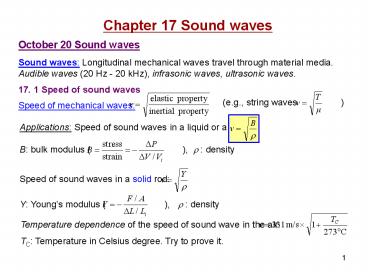Chapter 17 Sound waves PowerPoint PPT Presentation
1 / 10
Title: Chapter 17 Sound waves
1
Chapter 17 Sound waves October 20 Sound
waves Sound waves Longitudinal mechanical waves
travel through material media. Audible waves (20
Hz - 20 kHz), infrasonic waves, ultrasonic
waves. 17. 1 Speed of sound waves Speed of
mechanical waves
(e.g., string waves )
Applications Speed of sound waves in a liquid or
a gas B bulk modulus (
), r density
Speed of sound waves in a solid rod Y
Youngs modulus ( ), r
density
Temperature dependence of the speed of sound wave
in the air TC Temperature in Celsius degree.
Try to prove it.
2
17. 2 Periodic sound waves Compression and
rarefaction (produced by an oscillating piston)
Displacement of a small element of the medium
relative to its equilibrium
smax displacement amplitude of the wave
Variation in gas pressure
DPmax pressure amplitude of the wave
(To be proved)
1) A sound wave may be considered either a
displacement wave or a pressure wave. 2) The
pressure wave is 90º out of phase with the
displacement wave.
3
Example 17. 1 Derivation of DP
4
Read Ch17 1-2 Homework Ch17 (1-15)
4,5,13 Due October 31
5
October 22 Intensity of sound waves 17. 3
Intensity of periodical sound waves
Displacement of a slice element of air Its
speed Its kinetic energy (at t 0) Kinetic
energy in one wavelength
Total mechanical energy in one wavelength
Rate of energy transfer
Intensity power per unit area Intensity in
terms of pressure amplitude
6
Point source and inverse-square law
A point source emits spherical waves. If the
power is equally distributed in all directions
Example 17.3
Sound level in decibels
The range of intensities detectible by human ear
(at 1000 Hz) Threshold of hearing 110-12 W/m2
? Threshold of pain 1 W/m2
Determining sound level in a logarithmic scale
(reference intensity I0 110-12 W/m2 )
1) b is in decibels (dB). 2) Threshold of pain
I 1 W/m2, b 120 dB, Threshold of hearing
I0 1 10-12 W/ m2, b 0 dB
Quiz 17.3 Example 17.4
7
Read Ch17 3 Homework Ch17 (16-31)
18,20,24,26 Due October 31
8
October 24 Doppler effect 17. 4 The Doppler
effect Doppler effect The apparent frequency of
a wave changes because of the motion of the
source or the observer.
Principle
- I) Moving observer
- Wave front surface of constant phase.
- Sound speed v, observer speed vO (toward the
source) - speed of the wave relative to the observer v
vO - observed frequency
- II) Moving source
- Sound speed v, source speed vS (toward the
observer) - observed wavelength l vS T l vS / f
- observed frequency
9
III) Moving source and moving observer Sound
speed v, source speed vS, observer speed vO (one
toward the other)
Sign convention vS and vO are positive when
moving toward the other. Quiz 17.5 Example 17.6
Doppler submarines
10
Read Ch17 4 Homework Ch17 (32-41)33,35,62 Due
November 7

